Racial Hatred Unleashed
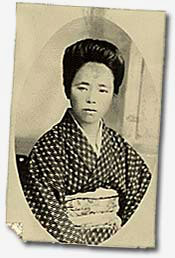 Many Issei women, first generation Japanese immigrants, such as Ai Hitaka shown in 1915, came to the United States as picture brides. (National Archives, image ARC 296466)
Many Issei women, first generation Japanese immigrants, such as Ai Hitaka shown in 1915, came to the United States as picture brides. (National Archives, image ARC 296466) While many Americans viewed German and Italian aliens with suspicion, they hated all things Japanese after the attack on Pearl Harbor. The severity of the reaction was apparent when the Tennessee Department of Conservation asked the state purchasing department to order six million licenses to hunt Japanese invaders at a fee of $2 each. The reply: "Open season on Japs'--no license required."
Footnote
1 The hatred had deep roots along the West Coast where anti-Asian racism had flourished for nearly a century. In this context, distinctions between unnaturalized Japanese aliens and Japanese American citizens often lost their relevance. Lt. General John DeWitt, head of the Western Defense Command, boiled it down to race and spoke for many along the West Coast: "...racial affinities are not severed by migration. The Japanese race is an enemy race."
Footnote
2 Experiences in Oregon
Earlier federal anti-immigrant laws effectively created two groups of people of Japanese descent in the United States. Issei, or first generation Japanese immigrants, were not allowed to become citizens; while Nisei, those born in the United States, were citizens. Despite constitutional protections, most Americans saw little practical distinction. The 1940 census found a total of 4,071 Issei and Nisei in Oregon, of whom 2,454 were citizens. Portland had the largest concentration at 1,680 combined population. The orchards of Hood River County counted 480 people with farming areas in Washington, Clackamas and Marion Counties representing other sizable concentrations of Japanese Americans. Statewide, men outnumbered women by nearly 2 to 1.
 Population table, 1940 Census of Japanese in Oregon Footnote
3
Population table, 1940 Census of Japanese in Oregon Footnote
3
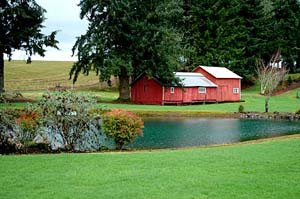 The farmland of Marion County played host to a significant community of people of Japanese descent. (Oregon State Archives Scenic Image 20050117-0325)
The farmland of Marion County played host to a significant community of people of Japanese descent. (Oregon State Archives Scenic Image 20050117-0325) State law also worked against Japanese aliens. The Issei largely built their own communities in the previous decades, relatively isolated from mainstream society by language and cultural differences. This contributed to strong and pre-existing racial prejudice in Oregon. Fearing Japanese immigrants were gaining too much farmland, the Ku Klux Klan lobbied the Oregon Legislature to take action in 1923. The Legislature responded by passing a measure outlawing Japanese aliens from owning land. In an indication of the overwhelming support, the House passed the measure with only one negative vote; the Senate vote was unanimous.
Footnote
4 The Drumbeat Grows Louder
With this history of racism, many Oregonians were eager to vent their anti-Japanese hatred in the wake of Pearl Harbor. Fueled by caustic radio programs and alarmist magazine articles, residents sent letters to Governor Sprague decrying the Japanese attack and demanding action. Alta Bridges of Saginaw, Oregon sent a handwritten letter to the governor (mistakenly confusing him with Senator Charles McNary) hoping he had been "listening to John B. Hughes every morning at nine O'clock." The Hughes radio program spewed racist invective against people of Japanese descent and Bridges had clearly absorbed much of it: "I am an American 100% [and] it makes me disgusted to think how the Alien Japs aslo [sic-and also] some Americin [sic] born, are allowed to go free to do thier [sic] dirty business against our government."
 Letter from Alta Bridges Footnote
18
Letter from Alta Bridges Footnote
18 E.M. Westhefer of Portland sent Sprague a telegram voicing a growing attitude:
Residents of Lakeview wanted action from the FBI to have their "sons of Nippon" moved, according to a State Defense Council field inspector's report in early 1942. Apparently the residents were "worrying about the 9 or 10 Japs who live here. The Jap laundry is directly under their water reservoir. This laundry is owned by K Kawaji who at this time is in the Japanese Navy, and another Jap who was recently arrested in Calif[ornia] as a spy."
Footnote
6Farm and Workplace Pressure
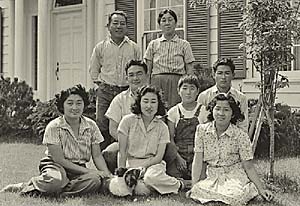 Many families of Japanese descent worked hard to achieve the "American Dream." Above, the Shibuya Family of Mountain View, California pose on the front lawn of their prosperous home in 1941. (National Archives, image NWDNS-210-G-A60)
Many families of Japanese descent worked hard to achieve the "American Dream." Above, the Shibuya Family of Mountain View, California pose on the front lawn of their prosperous home in 1941. (National Archives, image NWDNS-210-G-A60) Frank Warfield of Forest Grove had a suggestion about what to do with the Japanese American farmers in his area. Rather than send off the Japanese Americans, leaving their strawberry fields uncultivated, he recommended to Governor Sprague that "if people think they can't be trusted...why not let each grower hire these Japanese to do their hoeing & ect. [sic] and make it compulsory for each grower to hire a white American to guard and boss the workers requiring each worker to wear a number and report morning noon and nite being under guard at all times."
Footnote
7
Further pressure came in the workplace. The Union Pacific Railroad "found it necessary to relieve certain Japanese from their employment and felt the State should be advised of their whereabouts... All have been given three days to make up their minds where they are going and get off the property." No mention was made as to whether the fired employees were alien Japanese or Japanese Americans and no pretext for dismissal was given.
Footnote
8
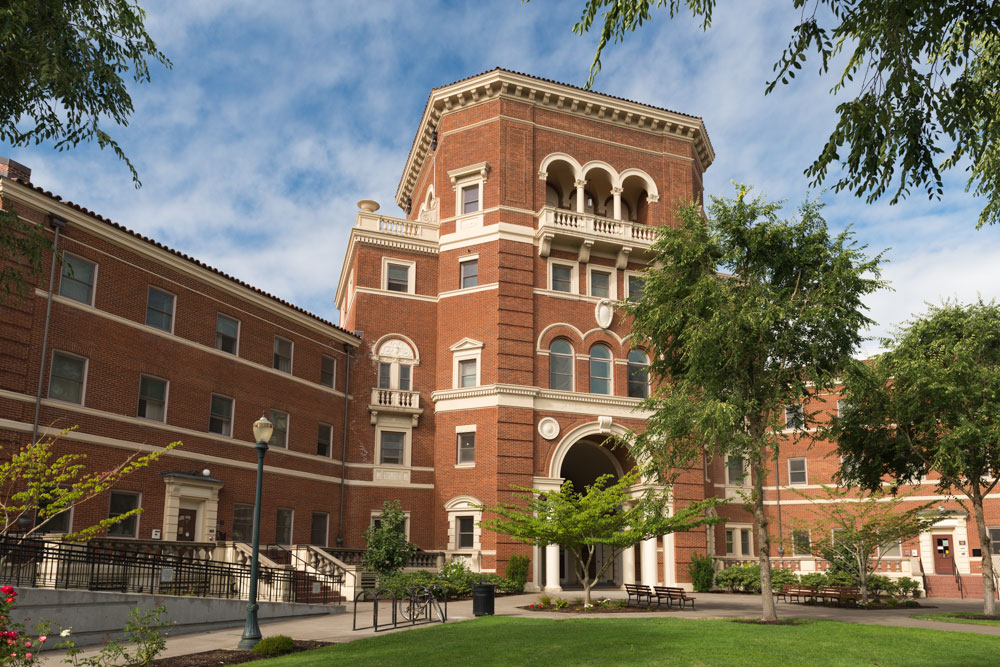 Weatherford Hall, Oregon State University (earlier College) campus, Corvallis. The college registrar defended the employment of a Japanese American woman from critics in the local American Legion. (Oregon State Archives Scenic Image 20150815-5688)
Weatherford Hall, Oregon State University (earlier College) campus, Corvallis. The college registrar defended the employment of a Japanese American woman from critics in the local American Legion. (Oregon State Archives Scenic Image 20150815-5688) The registrar of Oregon State College (now University) in Corvallis was forced to defend employee Molly Kageyama. The Corvallis Post #11 of the American Legion unanimously adopted a resolution condemning the appointment of Kageyama to the selective service register board. Registrar E.B. Lemon responded, first of all, that the accusation was false. Kageyama was not on the board, she simply worked in the office. Furthermore, Lemon protested it was "unfair and unnecessary to discriminate against one individual whose loyalty there has been no occasion to doubt. Molly Kageyama is an Oregon born girl, a graduate of Hood River High School and Oregon State College. Last year, while a senior student, she was sufficiently appreciated by her colleagues to have been elected to Mortar Board, which is regarded as one of the highest honors...."
Footnote
9
Portland came to be seen as a national leader in restricting Japanese American activities. In January the city council ruled that "no license of any kind be granted by the City of Portland to any Japanese national." The next month the city council passed a resolution calling on the federal government to move forward with the internment of all people of Japanese descent, including American citizens.
Footnote
10 Veterans Groups Demand Action
By February veterans groups, such as the American Legion and Veterans of Foreign Wars, were demanding that "all" Japanese be removed from western Oregon. The Scout Young Camp of the United Spanish War Veterans listed many reasons to "emphatically urge that all Japanese, whether American-born or otherwise, be immediately removed..." Their resolution implied that Japanese Americans in Portland were plotting massive sabotage:
A later resolution from the Scout Young Camp called for a prisoner exchange with the United States trading thousands of Japanese aliens for captured American soldiers "whose plight is so deplorable."
Footnote
12 A Valiant but Vain Response
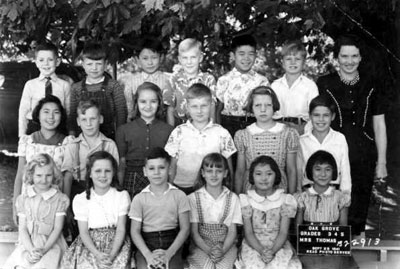 Grades 3-5 of the Oak Grove School in Hood River County show a mix of students of Caucasian and Japanese descent in September 1941. (Image courtesy www.carolynbrady.com)
Grades 3-5 of the Oak Grove School in Hood River County show a mix of students of Caucasian and Japanese descent in September 1941. (Image courtesy www.carolynbrady.com) The Japanese American Citizens League, Japanese churches, and other organizations tried to stem the overwhelming tide of sentiment in favor of the removal. Some went to great lengths to proclaim the loyalty of people of Japanese descent. The minister of the Hood River Japanese Methodist Church organized a pledge by local Japanese aliens proclaiming "our loyalty to the Stars and Stripes just as do our children who are patriotic American citizens...." They added that "we love this country so much that we wish to live here permanently...to cooperate whole heartedly, endeavoring to prove our destinies common with that of the American public." The signers noted that "fourteen of our American born boys of Japanese ancestry have answered the call to duty with the United States army. We hope there will be further opportunities to prove our mettle as good, law abiding nationals, maintaining the good will of our neighbors."
 Resolution of Hood River Area Japanese Aliens
Footnote
13
Resolution of Hood River Area Japanese Aliens
Footnote
13
Few non-Japanese American groups or individuals rose to protest the stampede. Most groups such as the Red Cross and YMCA, as well as many civil libertarians and churches, were mute to the issue. Some, however, did speak up. Days after Pearl Harbor, Clarence Oliver, a teacher at Portland's Jefferson High School, wrote a letter to Governor Sprague on "a matter of very grave importance." Oliver had long associations with Japanese Americans through school, church and in his home that convinced him they were "useful and loyal citizens." He called on Sprague to appoint committees of prominent citizens in counties with large Japanese American populations "to serve in a guardianship capacity for the people of Japanese blood residing in our state." He also suggested that American friends post bonds for the conduct of Japanese aliens in Oregon. In response, Sprague demurred, referring to the matter as a local one.
 Letter from Clarence Oliver to Governor SpragueFootnote
14
Letter from Clarence Oliver to Governor SpragueFootnote
14
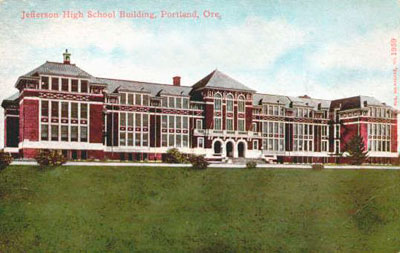 Clarence Olivier, a teacher at Portland's Jefferson High School (shown above), called on Governor Sprague to take action to protect the rights of Japanese Americans in Oregon. (Image courtesy www.vintageimages.net)
Clarence Olivier, a teacher at Portland's Jefferson High School (shown above), called on Governor Sprague to take action to protect the rights of Japanese Americans in Oregon. (Image courtesy www.vintageimages.net) In February other voices of support were heard, this time at the "Tolan Committee" of the U.S. House of Representatives that was holding hearings in Portland on the need to remove Japanese Americans from the West Coast. Some social welfare organizations, churches and personal friends of Japanese Americans spoke in support. A former missionary in Japan, Azalia Emma Peet was the only witness at the hearings to question the need for removal on moral grounds: "Is there anything in their history in this area to justify such fear of them developing overnight?" she questioned. Committee chairman, Representative John H. Tolan retorted: "So far, there are no cases of sabotage...[but] if the Pacific Coast is attacked, that is when the sabotage would come, with the attack, wouldn't it?"
Footnote
15 Governor Sprague Relents Under Pressure
The pressure on politicians to take a stand grew by the day in early 1942. Major Oregon newspapers, including
The Oregonian and Salem
Capital Journal, mirrored newspapers in California and elsewhere in calling for the evacuation of Japanese Americans. A poll of Portlanders on February 12 found 80% favored the removal of "all enemy aliens."
Footnote
16 Governor Sprague decided he could resist no longer. He had been challenged on the right in the Republican primary for governor by Secretary of State Earl Snell and needed to look strong on the issue to voters. On February 17, Sprague sent the following telegram:
Related Documents
Notes